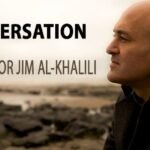Adalet R. Garmiany is a British & Kurdish Iraqi artist, curator and Chief Executive/Founder of ArtRole, an International based contemporary arts organisation developing international cultural exchanges with the Middle East. Adalet has been forging important cultural and artistic relationships between Iraq, Middle East, UK, across Europe, USA, and the rest of the world facilitating artistic dialogue, exchange and mutual support.
Scott Douglas Jacobsen: You were born in Kirkuk, Iraq in 1973. What was the original interest in performance art, music, and cultural productions?
My interest in music most probably came from the Qadri Sufi ceremony. I loved chant and the Daf musical instrument, and I still play even to this day. The Qadri Sufi ceremony is considered one of the most ancient spiritual ceremonies for Kurds. I was fascinated by Kurdish traditional weddings, colours, dancing and singing – all of which live within me and has thus become a part of my work. As for visual art, I was fortunate enough to be given a special talent: I was one of the most talented at drawing pictures in my primary school. I would draw relentlessly – I would even draw on walls without knowing how to use brushes and colour. Then, in 1989, I joined the Institute of Fine Arts in Mosul. Regarding culture productions, after working with international NGOs in Iraqi Kurdistan in the Nineties supporting culture industry in the region, and after I moved to live and study in the UK, I realised, personally, making only artwork wasn’t satisfying me enough, especially after seeing all the conflicts and devastation from my region. The arts environment in the UK helped me realised that I wanted to work as an art director and curator. I subsequently founded and helped established a number of art and culture groups and organisations, one of them being ArtRole.
Previously, you were a sculptor and painter. Why did you leave those for other interests?
I believe this has more to do with my nature. I have experienced all kinds of visual art forms as a painter and sculptor. In 1995 I considered creating an installation in Iraqi Kurdistan, then I started to read and write about postmodernism during the latter half of the Nineties whilst in Iraq, and in 2000 I started my BA in the UK and worked as artist which disclosed to me the various different ways in which I could understand, practically, new media and conceptual art. Later I realised I wanted to work in a larger ‘play space’ with more materials. I did this by way of a mixture of performance, installation and sound art – all of which brought my spiritual background in unison with all these elements. I managed to express myself more through these forms of art. Indeed, I expressed myself through the medium of public art on the street, art in nature, etc.
Also, you performed in a Qadri Sufi Group. You were a Kurdish drum (Dervish Def) player. What is the personal fulfilment and expression that comes from playing in a Qadri Sufi Group?
The area I grow up was dominated by the Qadri ceremony, and I was born in Qadri’s Holy town in Iraq. This spiritual Sufi ceremony helped me keep my balance and it protected me from getting lost in the chaos of decades-long wars. These wars caused untold distractions to everyone living there, and fostered, of course, a totally violent environment with houses constantly ablaze. About 80% of my family were killed by the Saddam regime. My entire childhood memory photos were destroyed. Many of my family members were imprisoned for no other reason than for being Kurdish. However, none of this makes me hate or vengeful because I didn’t allow myself to be the victim of their fascist agenda. Instead, I have tried hard to understand what it means to be human and to act as human in the most civilised way possible. This method of spiritual living that comes from within has built my personality and has found its way into my art and culture work.
What was the inspiration for the foundation of ArtRole?
Well, I worked with many civil society groups and NGOs, in Iraqi Kurdistan and in the UK, and I established the Kurdish Tradition Dance Group HATAW. AHRK was the main idea that I acquired during my time in the UK which was inspired by the work I did with the French NGO ‘Dia’, which works in the Kurdistan Region, with the co-creator of the Kurdish-Yorkshire Music group. Then, after the second Golf war in 2003, when I was in the UK, I thought I needed to act internationally and get engaged with the conflict zone through the medium of art, culture and educational programmes. I believed strongly that through art I can have a role to play in those massive misunderstandings that exist within and between communities, especially the connection between the Middle-Eastern and North-Africa region and the western world. Here the idea of ArtRole materialised, and with support of some passionate people such as Justine Blua, Mark Terry, Rob Gawthrop and Anna Bowman I established ArtRole on July 2004 in the UK in my small bedroom. This became an international organisation that extended across the globe. ArtRole created platforms for hundreds of artists, academics, activists, diplomats, curators, art and culture managers, art students, human right and civil society groups, etc., in order to establish a mutual understanding and dialogue between them and local authorities in the hope of creating unity concerning the value of culture and how people are connected despite apparent differences.
What are some of the eventual emotional difficulties and rewards in the creation of artistic exchanges with international creative communities?
There are many examples through our twelve years of continued work. One of the situations that was emotional for me occurred in 2009 when I organised a Post-War Art & Culture Festival in Sulaymania city, in the Kurdistan region of Iraq, at a venue called the Red Jail. The Red Jail used to be the security prison for Saddam Hussain’s regime which imprisoned thousands of Kurdish people – many of whom were tortured and executed. The Red Jail became the National Museum and one of the main artistic spaces in the whole of Iraq. During the time I was at the Red Jail, a time in which my mother visited me often, I created a performance called “Memory Game” which featured over 50 people participating – including international artists such as Richard Wilson and Anne Bean from the UK; ex-prisoners; my mum, etc. It was a very emotional moment. However, it was also rewarding to transform the building into a space which allowed people to freely walk back into it without coercion. Instead, people would enter for different reasons: to heal, to find optimism, and to look forward to a better future.
You are the founder & cultural director of AHRK (Asylum seeker & Refugees of Kingston-Upon-Hull). What is the content and purpose of this initiative?
I went to the UK as a political and humanitarian Refugee, and I was granted refugee status very quickly. In a matter of months, I met a very good amount of English people who suggested that I establish a group to support Asylum Seekers. The idea came together very quickly and I started a committee to run the group. As culture director, I proposed that we organise a culture event to introduce the group and refugee-culture to the public, which was a huge success. So the main idea was to help those who needed help by assisting them claim asylum, help them find a job, and even help them enrol in college courses (and many others kinds of support that they needed).
Also, as the AHRK cultural director and ArtRole Chief Executive, what tasks and responsibilities come with these positions?
Such things I could list include, but is not limited to, helping people and communities despite their differences; creating a platform to bring people together; establishing dialogue; and establishing mutual understanding through the medium of art, culture and education.
What is the probable future of Iraq, artistically and culturally (even in its basic existence as a state)?
Because there is a lack of infrastructure and a lack of political and social stability, as well as a lack of economic sustainability, there will be no real artistic and cultural environments growing from inside that area.
Your work focuses on the cultural ideas from the Middle East such as the historical, political, religious, and spiritual views. What brings these together in your professional work? How do you unite these varied perspectives in productions?
In the middle east, the religion and political division have had an extreme influence on people’s lives, especially those who are ethnic minorities. I have attempted to see these elements in my work through an artistic and cultural perspective. The spiritual views have given me a balance in which to see the things having substantial affects on our lives in a wide, horizontal dimension. This is the amazing thing concerning art and culture, i.e. there is no limit one can reach and no limit to which things can be brought together. That is why I managed to go as far as possible in bringing together those elements within and to metamorphose them in different ways.
For those who want to work together or become involved, what are the recommended means of contacting ArtRole, or you?
First, they will need to ask themselves what they want to accomplish. Anyone who wants to work in ArtRole will need to have a strong motivation and courage to work in the kinds of environments that ArtRole works in, environments that are both challenging and effectuate different ways of understanding what is happening in a given environment. The most important thing concerning people who join us is that they are contributing to these situations, contributions that have real affects on the lives of others. That’s what we have been doing voluntarily for many years, and why we always welcome people who have an interest in joining us.
Thank you for your time, Adalet.








Article Discussion